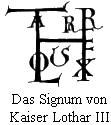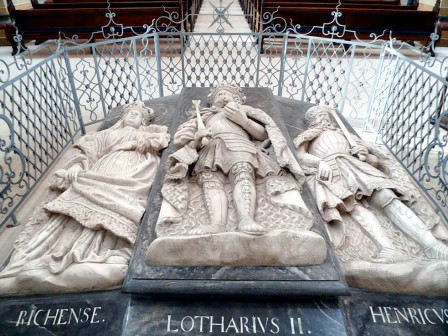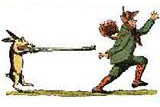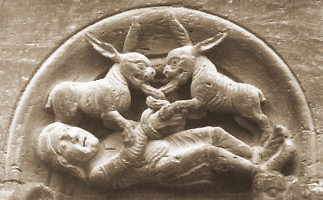Collegiate Church of St. Peter and Paul
The collegiate church at Königslutter, today commonly called the Kaiserdom (imperial ccathedral), is one of the most impressive Romanesque buildings in Lower Saxony. Lothar von Süpplingenburg (or Supplinburg), German king since 1125 and German emperor since 1133, donated it in 1135 as the monastery church of the Benedictine monastery he founded at the same time and gave it the form of a three-nave cruciform pillar basilica. The ornament-rich eastern sections of the cathedral were initially built according to the Hirsau building scheme*). After the emperor's death in 1137, the building was completed according to simplified, reduced plans.
The imperial cathedral gained special significance through the rich artistic decoration it was given by an Italian stonemason, the Master of Königslutter, as he is called in literature. The cloister on the south front of the cathedral is considered the most beautiful in northern Germany, and the enigmatic hunting frieze on the outer wall of the main apse is unique in all of Romanesque art.
The Romanesque imperial cathedral has been almost completely preserved. The west towers, however, were not completed until the 15th century, and around the same time the octagonal crossing tower received its beautiful tower frieze. Since the painting had almost completely disappeared except for very few remains from the Romanesque and Gothic periods in the choir, under the west towers and on some pillars of the nave, the church was repainted between 1891 and 1894.
Gerhard with Barbara and Johannes from Braunschweig in front of the Marian portal.
The lion portal on the north side is one of the most idiosyncratic Romanesque portals in Germany.
The ceiling of the nave was originally flat, the choir and transept were already vaulted. These were the first large vaults north of the Harz Mountains.
The cathedral's construction style acted as a model for many other sacred buildings. The special Königslutter style spread throughout southern Lower Saxony and further into the neighbouring regions as far as the Elbe - Saale.
View into the nave


Imperial Tomb
Emperor Lothar III died on 4 December 1137 in Breitenwang/Tyrol on his return from an Italian campaign and was buried on New Year's Eve 1137 in the still unfinished cathedral of Königslutter. His wife Richenza (+ 1141) and son-in-law, Duke Henry the Proud (+ 1139), as well as a child, presumably a son of the imperial couple who died at an early age, lie at his side.
Henry the Proud was the first husband of Gertrude, the daughter of Lothar and Richenza. At the time of their marriage in 1127, Gertrud was just 12 years old! From this marriage sprang
Henry the Lion

Here in the cathedral lies Emperor Lothar, his wife and son-in-law. Isn't there someone missing? Yes, that's right - the daughter! Where is the daughter Gertrud?
Go in search of Emperor Lothar's daughter Gertrud!
Click on the picture of Gertrud!
![]()
The Romanesque cloister is a true splendour. Every column in the cloister is designed differently. Unfortunately, only half of the cloister still exists.
Furtwängler & Hammer organ from 1892
The organ of the cathedral church was restored in 2010 and sounds again in its original condition.
Easter candlestick

The famous hunting frieze on the apse. The stone image programme by the Lombard sculptor Nicholas from 1135 is of enigmatic symbolism. The central motif in particular - two hares tying up a reclining hunter - has always puzzled art historians. In the preceding scenes of the frieze, things are still plausible: two hunters blow their horns, hounds rush a deer, sink their teeth into hare and boar.
An explanation can probably be found in medieval thought: The hares' revenge on the hunter.
A similar scene is depicted in the tympanum of the Romanesque church in Conquesist. In hell, two hares roast the bound hunter over the fire.

Doesn't the idea of the revenge-seeking hare remind us of Struwwelpeter?

Hares captivate hunters, hunting frieze in Königslutter
According to an interpretation by Berhard Kuck,
the devil is hiding here. ![]() Touch the picture with the mouse!
Touch the picture with the mouse!
Hares roasting bound hunter over fire, tympanum in Conques
The Cluniac reform ideas were spread from Hirsau to about 200 Benedictine monasteries in the German-speaking countries from 1079 onwards. Many of them show similar architectural forms. A columned basilica shows the following main features: double-towered west façade, antechurch in the west, flat ceiling, transept in the east, rectangular or apsidal choir end, five-part staggered choir, separated crossing, eastern nave bay with pillars and choir screens, the adjoining western bays with columns; cube capital, portal framing, no crypt, no gallery.

In search of Gertrud:
Gertrud von Supplinburg was probably born here in Königslutter or in Braunschweig. Her husband the Duke of Saxony, Bavaria and Tuscia (Upper Italy) found his final resting place here. He lies in a triple tomb with Gertrud's parents, Emperor Lothar III and Richenza von Nordheim. But Gertrud is missing.